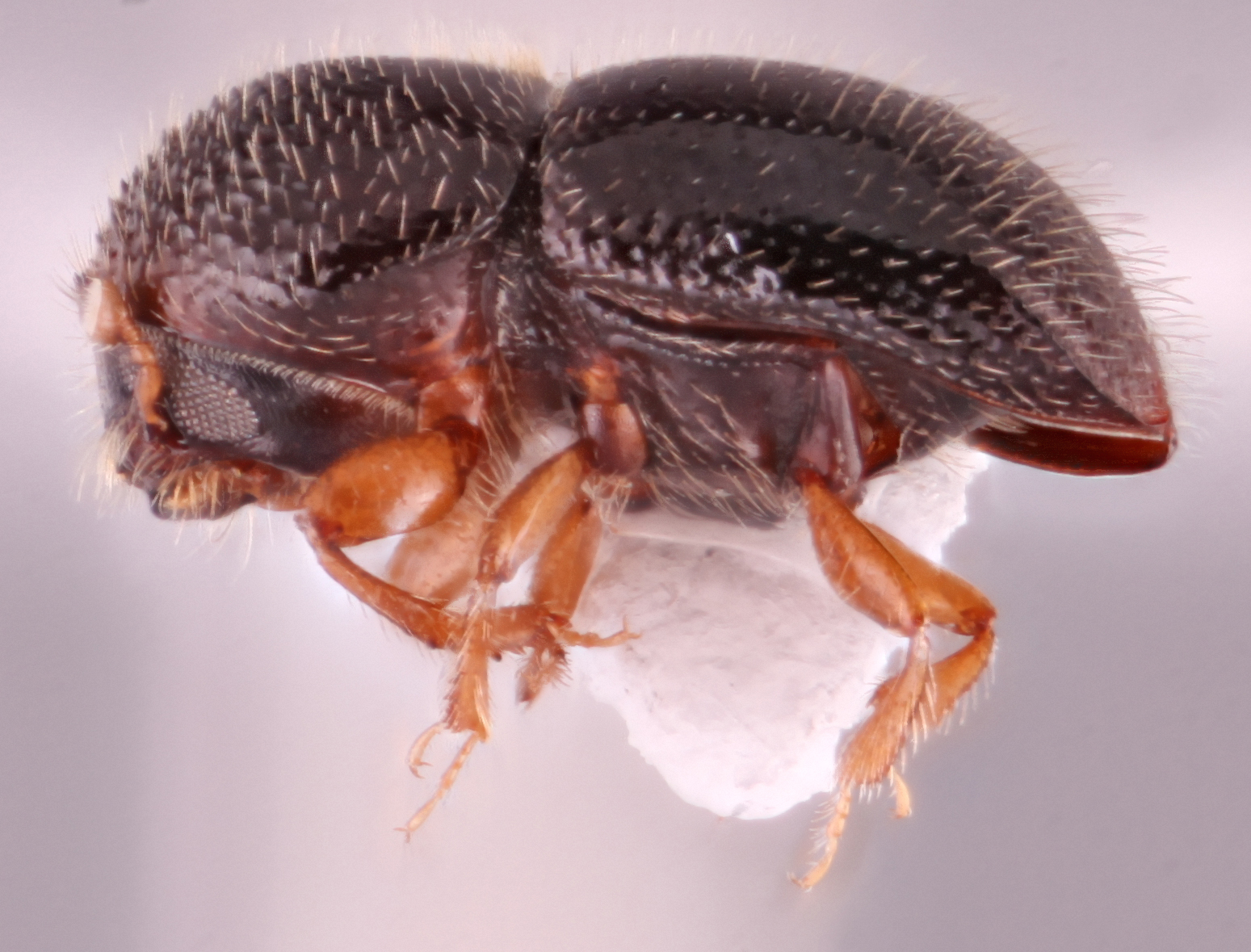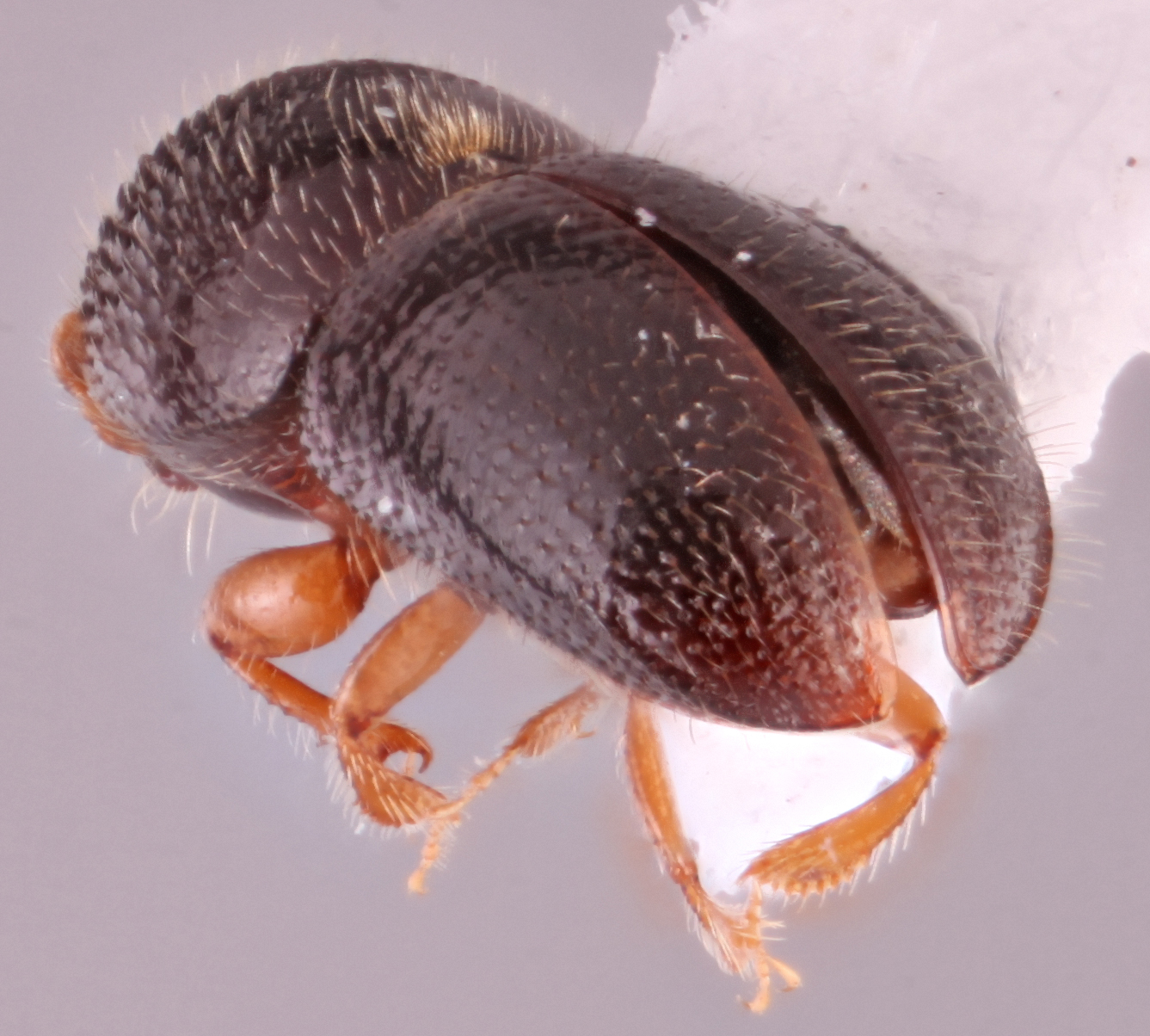Xylosandrus compactus
|
Xylosandrus compactus lateral; S.M. Smith |
|
Xylosandrus compactus dorsal; S.M. Smith |
|
Xylosandrus compactus declivity; S.M. Smith |
|
Xylosandrus compactus frontal; S.M. Smith |
Taxonomic history
Xyleborus compactus Eichhoff, 1876a: 201.
Xylosandrus compactus (Eichhoff): Nunberg, 1959: 434.
Synonyms
Xyleborus morstatti Hagedorn, 1912a: 37. Murayama and Kalshoven, 1962: 247.
Diagnosis
1.5−1.9 mm long (mean = 1.68 mm; n = 5); 2.0−2.5 times as long as wide. This species can be distinguished by its small size; elytralelytral:
'pertaining to the elytra
discdisc:
the flat central upper surface of any body part (e.g. pronotum and elytra) gradually curving toward declivitydeclivity:
gradually curving toward declivitydeclivity:
downward slope of either the pronotum or elytra
 , appearing rounded; elytralelytral:
, appearing rounded; elytralelytral:
'pertaining to the elytra
discdisc:
the flat central upper surface of any body part (e.g. pronotum and elytra) flat; posterolateralposterolateral:
flat; posterolateralposterolateral:
'relating to end of the side part/portion
 margins of elytraelytron:
margins of elytraelytron:
'
the two sclerotized forewings of beetles that protect and cover the flight wings
carinate to interstriaeinterstria:
'longitudinal spaces along the elytra between the striae, which is not as<br />
impressed and bear smaller punctures.
 7; declivitaldeclivital:
7; declivitaldeclivital:
pertaining to the elytral declivity
face with six punctatepunctate:
'set with fine impressed points, appearing as pin pricks
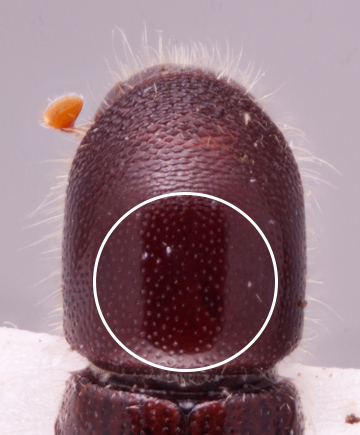 striae; striaestria:
striae; striaestria:
punctures in rows, which may or may not be impressed to make grooves setose, setaeseta:
setose, setaeseta:
small hair-like or scale-like structure
semi-recumbentsemi-recumbent:
pertaining to setae that are in between'erect and recumbent, usually at a 45 degree angle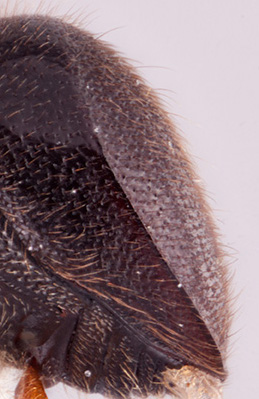 hairs and equal in length to the width of an interstriainterstria:
hairs and equal in length to the width of an interstriainterstria:
'longitudinal spaces along the elytra between the striae, which is not as<br />
impressed and bear smaller punctures.
 ; interstriaeinterstria:
; interstriaeinterstria:
'longitudinal spaces along the elytra between the striae, which is not as<br />
impressed and bear smaller punctures.
 granulategranulate:
granulategranulate:
'pertaining to a coarse, grainy surface texture'
 , uniseriate with erecterect:
, uniseriate with erecterect:
'pertaining to setae that have their apices directed away from the body and appear straight
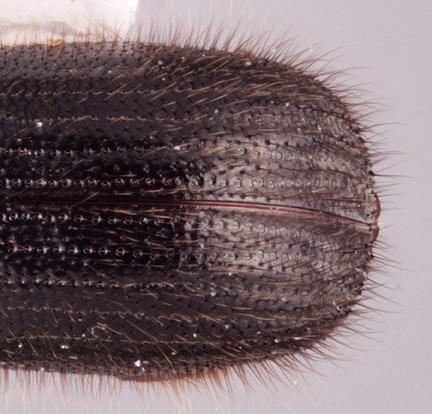 hair-like setaeseta:
hair-like setaeseta:
small hair-like or scale-like structure
longer than the width of two interstriae; pronotumpronotum:
'the dorsal surface of the thorax
as long as wide, from dorsaldorsal:
'of or relating to the upper surface; opposite of ventral
 view rounded (type 1) and laterallateral:
view rounded (type 1) and laterallateral:
'pertaining to the side
 view basic (type 0), summitsummit:
view basic (type 0), summitsummit:
highest point, used for pronotum and elytra, denotes the peak between pronotal frontal slope and disc, and between elytral disc and declivity at midpoint, basalbase:
at midpoint, basalbase:
point or edge closest to the body; opposite of apex half smooth, shiningshining:
half smooth, shiningshining:
appearing glossy or bright in luster; referring to a surface that is polished and reflects light well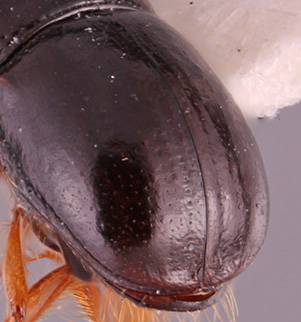 , sparsely minutely punctatepunctate:
, sparsely minutely punctatepunctate:
'set with fine impressed points, appearing as pin pricks
 ; and sparse mycangial tuftmycangial tuft:
; and sparse mycangial tuftmycangial tuft:
'tuft of setae that denotes the mycangia exterior opening
 on the pronotalpronotal:
on the pronotalpronotal:
'pertaining to the pronotum
basebase:
point or edge closest to the body; opposite of apex .
.
May be confused with
Xylosandrus adherescens, X. derupteterminatus, X. mesuae, and X. morigerus
Distribution
Circumtropical. Within the study region, recorded from China (Fujian, Guangdong, Guangxi, Guizhou, Hainan, Hong Kong, Hubei, Hunan, Jiangsu, Jiangxi, Sichuan, Yunnan, Zhejiang), India (Karnataka, Kerala, Tamil Nadu), 'Indochina', Japan, Laos, South Korea, Taiwan, Thailand, Vietnam. Established in the Neotropics, USA, and Europe (Wood 2007Wood 2007:
Wood SL. 2007. Bark and ambrosia beetles of South America (Coleoptera: Scolytidae). Brigham Young University, M.L. Bean Life Science Museum; Provo, 900 p., Garonna et al. 2012Garonna et al. 2012:
Garonna AP, Dole SA, Saracino A, Mazzoleni S, Cristinzio G. 2012. First record of the black twig borer Xylosandrus compactus (Eichhoff) (Coleoptera: Curculionidae, Scolytinae) from Europe. Zootaxa 3251: 64-68. https://doi.org/10.11646/zootaxa.3251.1.5, Gomez et al. 2018aGomez et al. 2018a:
Gomez DF, Rabaglia RJ, Fairbanks KEO, Hulcr J. 2018a. North American Xyleborini north of Mexico: a review and key to genera and species (Coleoptera, Curculionidae, Scolytinae). ZooKeys 768: 19-68. https://doi.org/10.3897/zookeys.768.24697).
Host plants
strongly polyphagous (Dole and Cognato 2010Dole and Cognato 2010:
Dole SA, Cognato AI, 2010. Revision of Xylosandrus Reitter (Curculionidae: Scolytinae). Proceedings of the California of Science 61: 451-545.)
Remarks
The biology has been reviewed by Browne (1961a), Brader (1964), Le Pelley (1968), Entwhistle (1972), and Beaver (1988), amongst others. This is a species of considerable economic importance because it can attack and breed in healthy shoots and twigs. The main economic host is coffee (Coffea spp.) (Rubiaceae), but it is also a pest of tea (Camellia thea) (Theaceae) in Japan, of cocoa (Theobroma cacao) (Sterculiaceae) and avocado (Persea americana) (Lauraceae) in Southeast Asia and elsewhere, and may kill seedlings and saplings of shade and forest trees (e.g. Browne 1968aBrowne 1968a:
Browne FG. 1968a. Pests and diseases of forest plantation trees: An annotated list of the principal species occurring in the British Commonwealth. Clarendon Press, Oxford, xi + 1330 pp., Le Pelley 1968Le Pelley 1968:
Le Pelley RH. 1968. Pests of coffee. London and Harlow, UK: Longmans, Green and Co. Ltd., Entwhistle 1972Entwhistle 1972:
Entwhistle PF. 1972. Pests of cocoa. Longman, London, 779 pp.).
DNA data
Sequences available for COI and CAD.

